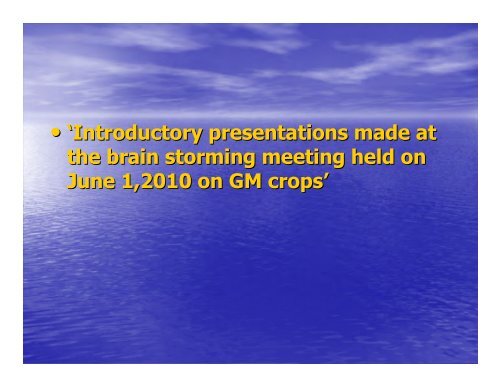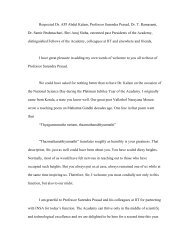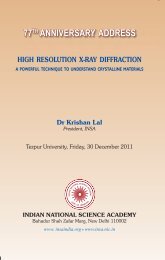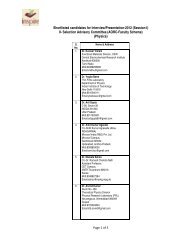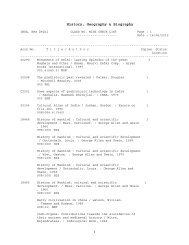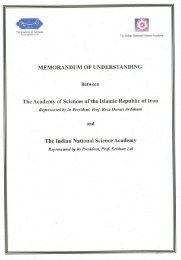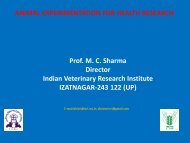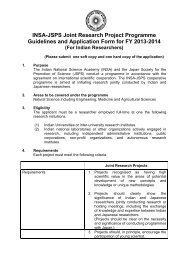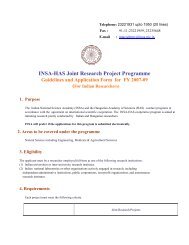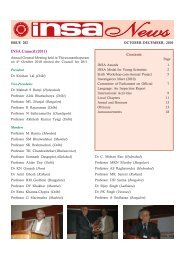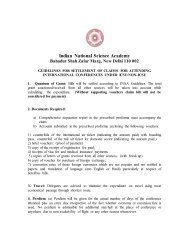GM Crops Presentation - Indian Academy of Sciences
GM Crops Presentation - Indian Academy of Sciences
GM Crops Presentation - Indian Academy of Sciences
You also want an ePaper? Increase the reach of your titles
YUMPU automatically turns print PDFs into web optimized ePapers that Google loves.
• ‘Introductory presentations made atthe brain storming meeting held onJune 1,2010 on <strong>GM</strong> crops’
• Pr<strong>of</strong>. G. Padmanaban
Beyond Bt BrinjalINSAJune 1, 2010
.The wide public consultations in the country broughtseveral concerns to the fore.The concerns are, <strong>of</strong> course, the standard ones: biodiversityissues, health safety, MNC strong hold, loopholes in theregulatory regime. The meetings were by and largedominated by crowds emotively orchestrated by activistsand demonstrations in street corners. A more effectiveinteraction in each centre could have been through havingan intense discussion with a limited group, representing allstake holders.
• The fact remains that a vast majority, including scientists,have not studied the issues involved, but have <strong>of</strong>feredcomments without any hesitation. It does become necessaryto take decisions in the best interest <strong>of</strong> the nation, guided bygenuine scientific inputs, rather than attempting aconsensus. I am not sure, a consensus can be ever reachedin any part <strong>of</strong> the world on this issue. Did India enter intothe nuclear deal based on a national consensus?
The biodiversity issue is crucial, since brinjal is ‘<strong>Indian</strong>’. Thegene flow studies carried out are not adequate. The trialsshould have been carried out in different environmentalconditions. Bt brinjal may affect the rich biodiversity <strong>of</strong> thisvegetable. The example given is Bt cotton, which isdominating over non-Bt cotton in the country.
• I wonder as to why Bt brinjal needs to be developed withall its advantages, if it does not become a popular choice.The approach would be to introduce Bt in every popularvariety <strong>of</strong> brinjal cultivated in different states, as has beenthe case with Bt cotton. Even in the case <strong>of</strong> non-transgeniccrops, is it not a fact that farmers prefer only certainvarieties and hybrids? What happens to biodiversity in thesecases. This is the price the society has to pay ever since manstarted practicing agriculture, targeting specific varieties andhybrids.
BIODIVERSITY I. Philosophically I have never understood the issue <strong>of</strong> biodiversitywith respect to transgenic crops carrying a couple <strong>of</strong> transgenes.This is in the context <strong>of</strong> horizontal and vertical transmission <strong>of</strong>genes taking place in nature all the time in evolutionary scale. Howdid the 2000 varieties <strong>of</strong> brinjal evolve? Can any one define apure, unadulterated line <strong>of</strong> rice in terms <strong>of</strong> the genome? How isthe biodiversity affected even if a couple <strong>of</strong> transgenes were toreach an unintended target, unless the transgene is a killer. Thelast two decades <strong>of</strong> experience clearly shows that Bt genes aresafe from that perspective. Bt brinjal is not a killer weed.Although, I respect the regulatory protocols on gene flowdemanded in transgenic crop trials, deep inside I believe that thebiodiversity card is overplayed. The government can createbiodiversity parks all over the country to preserve rare varieties <strong>of</strong>selected plant species .
How manygenes fromToesinte toCorn to BtCorn?!MesoAmericans converted Toesinte to edible corn byhybridization.The domesticated South American Tomato has evolved into 7500varieties.How did the 2000 varieties <strong>of</strong> Brinjal evolve?Radiation mutagenesis is a standard practice in hybriddevelopment.Why the opposition to a particular method <strong>of</strong> gene transfer?
Biodiversity IIThe environment has to beconstantly monitored for evolution<strong>of</strong> minor pests as major. Apart fromgene stacking, crop rotation needsto be scientifically planned. Bt cropis ideal to be part <strong>of</strong> IPM.
. Bt brinjal as a food crop cannot be equated with Bt cotton.The chronic toxicity tests carried out in experimental animals are notadequate. There are suggestions that chronic toxicity tests should becarried out during the entire life cycle <strong>of</strong> the animal. Solanacea is aunique species and the transgenes may bring the hidden toxins to thesurface. Brinjal is used in native medicine without cooking and abundantcaution needs to be exercised in assessing the health safety <strong>of</strong> Bt brinjal.
• As per EC-II report, the developers have indeed, carried out avariety <strong>of</strong> mandatory toxicity tests in a wide variety <strong>of</strong>experimental and domesticated animals. A 90 day chronic toxicitytest has been carried out. These tests have been considered asadequate by GEAC. One should also keep in mind that there is somuch published information already available on the safety <strong>of</strong> Bttoxins to humans and animals. More than this, Bt corn is beingconsumed across the globe for over a decade. Apart from beingcattle feed, the breakfast cereal in North America, perhaps,contains Bt corn. We cannot just discard the American experienceand state that it is not relevant for our discussion. In my perception,the greatest pro<strong>of</strong> <strong>of</strong> safety <strong>of</strong> Bt gene is the long termconsumption <strong>of</strong> Bt corn in many countries without any confirmedand authenticated ill effects to the public.
CHRONIC TOXICITYScientifically it is well known that Bt proteins get degradedin the acidic stomach <strong>of</strong> the mammal, whereas it getsactivated under the alkaline conditions <strong>of</strong> the gut in thepests. It gets degraded during cooking. Its penetrance in thesoil and micr<strong>of</strong>lora is not <strong>of</strong> real concern. In spite <strong>of</strong> all thesearguments, the chronic toxicity tests in rodents can becarried out for 6 months or even a year, if that would satisfythe requirement. I personally do not see the logic inextendedstudies.
Bt brinjal has been developed by Mahyco in which Monsanto has astake <strong>of</strong> 26%. The gene belongs to Monsanto. Priority needs to be givento the commercialization <strong>of</strong> indigenously developed transgenic products.China has developed Bt rice indigenously and has approved trials thatwould lead to commercialization.First, the support for indigenous development is definitely welcome.There are atleast a few events, both in the private and public sectors,that are ready for trials towards commercialization. But, one needs totalk to the scientists concerned to understand the trials and tribulationsthey undergo to take their transgenics forward.On the one hand they have to face the tough requirements <strong>of</strong> RC<strong>GM</strong>and GEAC, constant interference by activists directly or indirectly,Supreme court ruling that actually allowed on going trials (Mahyco), butclamped an embargo on newer trials that were ready (indigenous) andon the other, face an uncertain future in terms <strong>of</strong> publications and careeradvancement (public sector) and survival (private company). Is this theright environment for indigenous development <strong>of</strong> commercialcapabilities?
CHINA POLICYAs regards China, it has followed a dual policy. It hasapproved specific <strong>GM</strong> products developed by MNCs (eg.<strong>GM</strong>corn and Soya), while developing its own Bt rice. As per anews item (November 4, 2009/PR news shire- First call),Monsanto was opening its first research center inZhongguancum, Beijing. Monsanto has made a commitmentto collaborate with Chinese scientists on advanced biotechand breeding technology. China is pragmatic. It wants to getthe best <strong>of</strong> both worlds. We are driven by emotional activism.It is not as if that there is no opposition to <strong>GM</strong> technology inChina. But, it is able to take decisions and move ahead. It isable to keep the big picture in perspective, namely foodsecurity to an over billion population and an intense ambitionto become the world leader. I will not be surprised if we willbe importing Bt rice from China at some point <strong>of</strong> time!
Examples <strong>of</strong> indigenous commercialeffortsGly genes from ICGEB to industryBt cry 1AC from NRCPB to give BikaneriNermaBt Brinjal cry 1Fa1 from NRCPB toindustrySynthetic Bt genes developed andtransferred by NBRI, MetahelixBarstar-Barnase in mustard from Southcampus (in the process)
Resistance development is a serious concern inmonophagous pests.By far this is the most serious issue, which scientists shouldaddress as the primary challenge. Two different hypothesisare available to explain the mode <strong>of</strong> action <strong>of</strong> Cry toxins. Oneis based on generating pores (punching holes) in the insectgut cell and the other is based on killing mediated by signaltransduction. In both the models, the first steps envisagedare similar. The ingested toxin is cleaved by midgut proteaseand the activated toxin binds to cadherin receptor located inthe microvilli <strong>of</strong> midgut cells. The toxin oligomer then bindsto secondary receptors anchored to the membrane such asaminopeptidase N or alkaline phosphatase. The toxinoligomer then inserts into lipid raft membranes formingpores and causing the cells to burst. In the second model, thebinding <strong>of</strong> toxin to cadherin receptor is visualized to trigger asignal transduction cascade, eventually leading to oncotic celldeath.
MECHANISMS OF RESISTANCEMechanisms <strong>of</strong> resistance development have been studied indifferent pests induced to become resistant in the laboratory.In general, the most frequently observed mechanism is dueto defects in receptor binding followed by resistance due todefects in protease production, elevated immune response,enhanced esterase production etc. Strategies to overcomeresistance include development <strong>of</strong> Bt plants with novel Crytoxins (eg.VIP3 – plants), Cry gene stacking (eg. Cry 1Ac withCry 2Ab), modified Cry toxins that bypass primary receptorinteraction (eg.Cry 1A Mod toxins), use <strong>of</strong> Cyt proteins fromBt i strain along with Cry toxins and use <strong>of</strong> cadherinfragments to counter resistance (Bravo, A and Soberon, M(2008). How to cope with insect resistance to Bt toxins?Trends in Biotechnology Vol.26, 473-579).
GENE STACKINGIn addition, on the field use <strong>of</strong> refuge cropping hasbeen shown to be effective. It is clear that indeveloped countries there is already a switch to theuse <strong>of</strong> Bt crops with stacked genes. Indigenousefforts should only be towards developing Bt plantswith stacked genes. Monsanto has already indicated<strong>of</strong> possible resistance development in Gujarat topink boll worm in Bt cotton and has recommendedthe use <strong>of</strong> second generation Bollguard with twostacked genes. I wish there is an <strong>Indian</strong> authoritywhich gives this advice based on a constantmonitoring <strong>of</strong> the <strong>GM</strong> crops in the field.
. India needs an independent authority to evaluate and approve thetrials as well as to monitor the performance <strong>of</strong> <strong>GM</strong> crops in the fieldaftercommercialization.A unified National Biotechnology Regulatory Authority (NBRA) is underconsideration. The bill pending since 2005 is likely to be taken up in theparliament for debate. I feel that the regulatory authority to evaluateand monitor transgenic crops in experimental fields and the one thatperforms a regulatory function after commercialization should bedifferent. GEAC can continue to perform the former function and giveapproval for commercialization. GEAC has evolved over several years <strong>of</strong>experience and, perhaps, it is not a good idea to disband the same. Itmay need some more fine tuning. Thus, these two authorities can be twoarms <strong>of</strong> NBRA in the Agriculture sector. The biggest challenge is to createindependent and dedicated experimental facilities to monitor andevaluate <strong>GM</strong> crops. Till such a facility comes into existense, the existinglaboratories in different institutions have to be net-worked to provideindependent experimental capabilities for NBRA.
Steps in the development <strong>of</strong> Bt brinjal1. Nature and effect <strong>of</strong> genetic modificationcry 1AC against Fruit & Shoot Borernpt11 gene, aad gene – Kanamycin & Streptomycin/Spectinomycin selected markersExpression and Stability.2. Environmental Safety Assessmenta. Potential gene transfer to wild relativesb. Extent <strong>of</strong> outcrossing, pollen flowc. Gene transfer from brinjal to other plantsd. Gene transfer from brinjal to other organismse. Potential for relative weediness <strong>of</strong> Bt Brinjal event EEI.f. Impact on non-target organisms, including soil impact.3. Food and Safety assessmenta. Toxicity and allergenicity (Skin, mucous membrane tests) .b. Digestive fate (cry1AC, npt11).c. Compositional analysis.d. Feed to rabbits, fish, chicken, goat, cow.(Expert Committee II Report, 2009.)
Regulatory SystemRDACIBSCRC<strong>GM</strong> ( 30+ members)----- MNGGEAC( 30+ members)—MNGSBMCDBMC(
AGENDAGene StackingCrop RotationBt as part <strong>of</strong> IPMAgricultural practices to integrate <strong>GM</strong> cropsSi RNA approachMinor PestsMarker-FreeStage-Specific PromoterImproved Nutrition &Abiotic Stress
Finally, none <strong>of</strong> these agenda should delay the release <strong>of</strong> Bt brinjalBt Corn was introduced with a single Bt gene and antibiotic mrkers.We are loosing precious time.Nearly, 25 countries, including Europe have gone for this technologyBt cotton has convinced many farmers to go for this technologySuccess <strong>of</strong> Bt brinjal would convince public <strong>of</strong> the benefits <strong>of</strong> thistechnologyBt Rice with improved nutrition and ability to grow in low rainfall and salinesoil would revolutionalize <strong>Indian</strong> AgricultureScientists involved (private and public) are bewildered and shattered.
<strong>GM</strong> crops (Indigenous development)Brinjal, Cabbage, Cauliflower, Cotton, Groundnut, Maize,Chickpea, Mustard, Okra, Pigeon Pea, Potato, Rice, Sorghum,TomatoInstitutions involvedMahyco, TNAU, UAS (Dhrawad), Nunhems India, Rasi, Nuziweedu,Ankur, JK Seed, ICRISAT, Monsanto Mumbai, CPRI, NIPGR, NRCS,IARI, Metahelix, Bejo Sheetal , UDSC, ICGEB etc,Genes: cry 1Ac, cry1cA, cry 1Ab, ama 1, Rb, cry !b, cry 2Ab, cry 1Bcry1Aa fusion, chi 11, synthetic cry genes, Barnase-barstar, gly 1,gly 2, helicase etc
WORLD IS MOVING AHEADEuropean Union has accepted <strong>GM</strong>.(Amflora -<strong>GM</strong> Potato)France, Germany on selective basisGS ( Genuity SmartStax) Corn with 8 transgenesdeveloped( aerial pests, subsoil pests, herbicide tolerance)China has approved commercial Bt rice trials
How green biotech turned white and blueLucas LaursenJournal name: Nature Biotechnology Volume: 28, Pages:393–395 Year published: (2010) DOI: doi:10.1038/nbt0510-393Argentina has blazed a trail as one <strong>of</strong> the leading geneticallymodified (<strong>GM</strong>) crop producers. Can other developingcountries import the seeds <strong>of</strong> its success? With growingmarkets in China, India and elsewhere, Argentina and itsneighbors will continue trying to capitalize on theircompetitive advantages growing soy, cotton and maize. Butthe cost <strong>of</strong> distribution will depend heavily on internationalagreements, such as the pending EU approval schedules.Those challenges, which Argentina has navigated thus far,might be enough to make other countries think twice abouthow to implement their own biotech crop plans, but at leastin Argentina, Yankelevich says, “there's no going back.”
Agriculture is not just about technology, since itembodies a culture and there are political andsociological over tones. It needs to be realized that<strong>GM</strong> is only an innovative approach to provide atechnological solution, but it should not be made ascape goat if there is failure else where.Let us not throw the baby with bath water
1. Limited release <strong>of</strong> Bt Brinjal seeds to be tested andevluated in specific farmers’ fields from different states.Tobe strictly monitored by an independent committee2. Accelerate the indigenous efforts to commercialise pestresistant,abiotic-stress resistant hybrids/ varieties withimproved nutrition content.3. NBRA (Agri) should have two components. GEAC and<strong>GM</strong>MC (<strong>GM</strong> Crop Monitoring Committee). An effectivetechnical advisory system for the farmer.4. Decision on <strong>GM</strong> crops needs to be taken in Parliamentbased on scientific data and the benefit that would accrue tothe country. A public consensus is neither feasible norpossible.5. Decision on case to case basis6. An expert committee to decide on <strong>GM</strong> priorities.RECOMMENDATIONS
THANK YOU
• Dr. H.S. Gupta
Bt Brinjal, Transgenic <strong>Crops</strong>&BRAIH. S. GuptaNational <strong>Academy</strong> <strong>of</strong> Agriculture <strong>Sciences</strong>NASC Complex, Pusa CampusNew Delhi – 110 012:
What is Bt brinjal?Genetically engineered cropexpressing a gene encoding aninsecticidal protein <strong>of</strong> a soilbacteriumBacillus thuringiensis (Bt)
DO WE NEED Bt-BRINJAL?
Brinjal Shoot and Fruit Borer(Leucinodes orbonalis)
Pulses, Oil8%Plantation8%Fruits,Veg13%Cotton54%Rice17%Cotton Rice Fruits,Veg Pulses, Oil PlantationANNUAL PESTICIDE CONSUMPTION50,000 Metric Tons; Rs 3,500 crores
PUNJAB’S TRAGEDY IS NATION’S TRAGEDY
Insect Pest Management:Imperatives• Drastic reduction in pesticide use• Eco-friendly and sustainable strategies• Bio-pesticides- Bt formulation used for long• <strong>GM</strong> crops – A tangible and long term strategy
Bt-BRINJAL VARIETIES(Fruit Borer Protection by cry 1Ac)Trials at IIVR, UAS-D, TNAUPUBLIC-PRIVATE PATNERSHIP WITH M/S MAHYCOABSP II
AICVIP FIELD TRIALS WITH BT BRINJAL HYBRIDSField Trials Reduction ininsecticide useIncrease in fruityield (%) overFor FSB All pests Non-Bt2004-05 80.0 40.4 154.22005-06 74.5 43.2 113.0Average 77.2 41.8 133.6AICVIP, ICAR, 2007
Is Bt-brinjal Biosafe?
Bt-Brinjal Event EE 1– Biosafety Tests- Pollen flow studies - 2 Locations (Mahyco).- Germination and weediness studies (Mahyco).- Aggressiveness studies (Mahyco).- Molecular characterization and event ID (Mahyco).- Acute oral toxicity studies in rats (Intox, Pune).- Mucous membrane irritation test in female rabbit (Intox, Pune).- Primary skin irritation test in rabbit (Intox, Pune).- Effects on non-target and beneficial insects (Mahyco).- Sub chronic oral toxicity study in Sprague Dawley rats (Intox, Pune).- Assessment <strong>of</strong> allergenicity <strong>of</strong> protein extract using Brown Norway Rats(Rallis, Bangalore).- Responses, as a dietary feed ingredient to common carp growthperformances (Central Institute <strong>of</strong> Fisheries Education, Mumbai).- Chemical fingerprinting <strong>of</strong> Bt and non-Bt brinjal (including alkaloids)(IICT, Hyderabad).- Sub-chronic (90 days) feeding-New Zealand rabbit (Advinus, Bangalore).- Effect on performance and health <strong>of</strong> broiler chickens (CARI, Izatnagar).- Sub-chronic (90 days) feeding studies in goats (Advinus, Bangalore).- Feeding studies in lactating crossbred dairy cows (GBPUAT, Pantnagar).
SOCIO-ECONOMIC ASSESSMENT OF Bt BRINJALWill reduce use <strong>of</strong> insecticides and increase the marketableyieldAggregate economic gains around US$108 million per yearBenefits for farmers' health from reduced insecticideapplications are worth an additional $34 million per yearAvailability <strong>of</strong> OPVs would make the technology moreaccessible especially to resource-poor farmersKrishna & Qaim, 2008
Bt - CROPSCOTTON, MAIZE, RICE and POTATOUSA, Australia, China, Argentina, SouthAfrica, Spain, Germany, France,Bulgaria, Indonesia, Canada, Romaniaand India46 mha out <strong>of</strong> 134 mha <strong>of</strong> transgenic crops -2009Bt- Cotton – a Success Story in India
Area, Production and Productivity <strong>of</strong> CottonExported 8 million bales during 2009-10
1432
Future Demand for food grainsStudy Demand for 2020(million tonnes)1. PlanningCommission2472. Other studies 253 to 280• Yield <strong>of</strong> the food crops plateuing• Biotic & abiotic stresses increasing• Natural resources are degrading• Climate change has further compounded the problemGlobal cereal demand in 2020 to increase by 40%We have to maintain self-sufficiency in food grainsCrop improvement programs to be pursued vigorously makingbiotechnology & <strong>GM</strong> crop as a major partner
Questions We Need to Address1. <strong>GM</strong> crops are reality- should we use this powerful technology or wait& watch2. <strong>GM</strong> crop is not a panacea but can we feed ever growing populationwithout deploying this technology?3. Similar outcry was raised when hybrids were released, and in early1970s about research on rDNA – creation <strong>of</strong> deadly viruses – wipingout human race etc..4. Vaccines based on rDNA technology are accepted. Why not inAgriculture5. Should irrational obstacles without scientific basis & speculative fearhold us back?6. We missed industrial revolution in the past. Do we want to miss thisrevolution in biotechnology?7. Dispassionate assessment <strong>of</strong> the technology and come out with clearpolicy
Progress in AgricultureNature has been transferringgenes at its own pace. Thus,it has indeed been doing‘Genetic Engineering’ butslowly.What we are doing today isat accelerated pace.Science-led AgricultureDomesticationSelectionBreeding HYVHybridsTransgenics (<strong>GM</strong>)
BIOTECHNOLOGY REGULATORYAUTHORITY OF INDIADepartment <strong>of</strong> BiotechnologyGovernment <strong>of</strong> India
ORGANOGRAM OF BRAIChairperson, BRAI andtwo members
The Biotechnology Regulatory Authority <strong>of</strong> India Bill, 2009Suggestions proposed by NAAS• BRAI should strictly act as a single window clearance system• BRAI should confine to biosafety clearance with regard to food,feed or environment.• Once declared safe by the BRAI, the <strong>GM</strong> crop/genotype shouldenter into :a) the AICRP <strong>of</strong> the ICAR, which evaluates and monitors the improvement inproductivity or quality <strong>of</strong> the newly developed crop varieties/hybrids (whether bredthrough conventional or biotechnological methods)b) the multi location performance trial (VCU) as proposed under the New SeedBill, 2004 for the purpose <strong>of</strong> Registration <strong>of</strong> plant varieties in commercial use.
• Once a <strong>GM</strong> crop is declared safe by BRAI it should begoverned by the prevailing Seed Act with respect toimprovement in productivity or quality.• Import <strong>of</strong> <strong>GM</strong> crops/seed material should continue to berouted through NBPGR, as is the case currently under thePlant Quarantine Order, 2003.• BRAI should have synergy with Food Safety and StandardsAuthority, and Biological Diversity Authority <strong>of</strong> India.•The inter-ministerial advisory board may also include amongothers a representative <strong>of</strong> DARE
The Biotechnology Advisory Council should include thefollowing:• Plant Breeders (two in number) instead <strong>of</strong> Plant Scientists• Agricultural Extension Expert (One)• Social Scientist (one)• Medical doctor <strong>of</strong> eminence (one)The Technical Members <strong>of</strong> the Appellate Tribunal have beenreferred as Part time members in the Bill. Since ‘they shallnot hold any other <strong>of</strong>fice during their tenure as such’, theyshould also be given the status <strong>of</strong> full time members.
PROPOSED MANAGEMENT STRUCTURE: GOVERNANCE• The Authority shall consist <strong>of</strong> a Chairperson and two whole-timemembers.• The Chairperson shall be a person <strong>of</strong> outstanding scientific calibre witha Ph.D., M.D. or equivalent in a field relevant to the mandate <strong>of</strong> theAuthority• To hold the rank <strong>of</strong> Secretary to the Government <strong>of</strong> India.• The Chairperson and Members <strong>of</strong> the Authority, to be appointed by theCentral Government through selection committee chaired by Cabinetsecretary including scientific experts and others• To be supported by two advisory bodies: an Inter-ministerial AdvisoryBoard (IMAB) and a National Biotechnology Advisory Council (NBAC) inthe governance <strong>of</strong> the BRAI
PROPOSED MANAGEMENT STRUCTURE: GOVERNANCE• The Authority shall consist <strong>of</strong> a Chairperson and two whole-timemembers.• The Chairperson shall be a person <strong>of</strong> outstanding scientific calibre witha Ph.D., M.D. or equivalent in a field relevant to the mandate <strong>of</strong> theAuthority• To hold the rank <strong>of</strong> Secretary to the Government <strong>of</strong> India.• The Chairperson and Members <strong>of</strong> the Authority, to be appointed by theCentral Government through selection committee chaired by Cabinetsecretary including scientific experts and others• To be supported by two advisory bodies: an Inter-ministerial AdvisoryBoard (IMAB) and a National Biotechnology Advisory Council (NBAC) inthe governance <strong>of</strong> the BRAI
PROPOSED MANAGEMENT STRUCTURE:REGULATORY BRANCHES• Agriculture, Forest and Fisheries Branch (AFFB) to regulate <strong>GM</strong> plants,animals and micro-organisms used in agriculture, forestry or fisheries,including aquaculture.• Human and Animal Health Branch (HAHB) to regulate geneticallymodified organisms with applications in human and veterinary health,such as assessing the potential environmental risks and benefitsassociated with the application <strong>of</strong> <strong>GM</strong>Os in pharmaceutical developmentor recombinant livestock vaccine production.• Industrial and Environmental Applications Branch (IEAB) to regulate<strong>GM</strong>Os used in industrial manufacturing and in environmental applications,such as the use <strong>of</strong> <strong>GM</strong>Os for bioremediation <strong>of</strong> contaminated sites or oilspills.• Other branches as per need in future
ADVISORY BODIES• The Inter-ministerial Advisory Board (IMAB): To promoteand ensure inter-ministerial coordination with regards theimplementation <strong>of</strong> the regulatory system. The Board willinclude high level representations from key line ministries.• The National Biotechnology Advisory Council (NBAC): Toaddress overarching policy-related issues that may affectthe regulation <strong>of</strong> biotechnology in India. The Councilmembers will include representatives from the scientificcommunity, farmers , consumers, public and private sectorand civil society.
Reports <strong>of</strong> studies accepted by the regulatoryauthorities in various countries.•Assessment <strong>of</strong> the in vitro digestive fate <strong>of</strong> B.t.k. HD73 cry1Ac protein B.t.kHD-73 protein•A Dietary Toxicity Study with parasitic hymenoptera (Nasonia Vitripennis)•Evaluation <strong>of</strong> the dietary effect(s) <strong>of</strong> purified B.t.k. endotoxin proteins onhoney bee larvae•Evaluation <strong>of</strong> the dietary effect(s) <strong>of</strong> purified B.t.k. endotoxin proteins onhoney bee adults•B.t.k. HD-73 protein: A dietary toxicity study with ladybird beetles•B.t.k. HD-73 protein: A dietary toxicity study with green lacewing larvae•Effect <strong>of</strong> Bacillus thuringiensis insecticidal protein cry1Ab, cry2A, cry3A onFolsomia and Xenylla grisea (Insecta: Collembola)•Acute oral toxicity <strong>of</strong> Bt var. kurstaki cry1Ac HD-73 protein-albino mice.•Assessment <strong>of</strong> degradation <strong>of</strong> neomycin phosphotransferase II (nptII) proteinin in vitro mammalian digestion models•Acute oral toxicity study <strong>of</strong> nptII protein in albino mice
Bt-Brinjal – Expert Committee I - 2006Expert Committee recommended additional studies•Field trials under IIVR, Varanasi•Crossability studies with wild relatives - IIVR•Soil impact assessment (Micr<strong>of</strong>lora) - IIVR•Socio-economic study – NCAPComplied – 2007-2008
Bt-Brinjal – TimelineJanuary 2009Expert Committee (II) headed by Dr A.R. Reddy assessed all the biosafetystudies,additional studies as per EC-I and also the concerns raised by various scientists,NGOs and other stakeholders.October 14, 2009: GEAC approved Bt brinjal hybrids and varieties with respectto environmental Safety.January 13 th to February 6 th , 2010: Union Environment Minister Mr JairamRamesh held Public consultations with scientists, farmer’s outfits, consumergroups and non-governmental organizations.February 9, 2010Union Environment Minister announced that a moratorium on the release <strong>of</strong> Btbrinjal is imposed.Prime Minister’s Statement (February 24 , 2010):GEAC to address all concerns for resolving all scientific issues relating to Btbrinjal including safety aspects
GLOBAL AREA OF BIOTECH CROPSMillion Hectares (1996 to 2009)20018016014012010080604020“Trait Hectares”Total HectaresIndustrialDeveloping25 Biotech Crop Countries01996 1997 1998 1999 2000 2001 2002 2003 2004 2005 2006 2007 2008 2009A record 14 million farmers, in 25 countries, planted 134 million hectares (330) millionacres in 2009, a sustained increase <strong>of</strong> 7% or 9 million hectares (22 million acres) over2008.Source: Clive James, 2010.
THANK YOU
Dr. P.C.Kesavan
Brainstorming Session on Transgenic<strong>Crops</strong> (INSA, New Delhi)Need for Holistic Approach in evaluatingTransgenic <strong>Crops</strong>1 st June 2010P.C. KesavanDistinguished FellowM.S. Swaminathan Research Foundation, Chennai.andHonorary Pr<strong>of</strong>essorCentre for Sustainable Development, IGNOU, New Delhi.
Modern Biotechnology as <strong>of</strong> now• Inadequate Scientific Premise; strong commercial push• Random, unpredictable insertion <strong>of</strong> transgene – position effect? L-tryptophan from transgenic bacteria,Beltsville pig etc.• Inadequate understanding <strong>of</strong> the implications <strong>of</strong> breaking the naturally – evolvedsexual barriers to gene exchange from widely different taxa.• Questionable premise – “Bt is specific to Lepidopteran pests”• “Substantial equivalence” – Scientifically untenable, but commerciallyfavourable philosophy.• Students <strong>of</strong> ‘Genetics and Evolution’ know:• Copying nature Seldom yields desired results, but going against it spells doom.↔ e.g. induced polyploidy – nature vs induced↔ Induced mutations – eg. Dwarfing genes <strong>of</strong> desired type could not be induced.Nature provided these in the form <strong>of</strong> “Norin” in wheat; “Dee-gee-woo-gen” in rice.P.C. Kesavan and S. Malarvannan
Pest EcologyPrevalence <strong>of</strong> pests and their natural enemies in the IPM* and Non-IPM** cotton fieldsPopulation statusInsect PestsIPM adopters*Non-IPM IPM adopters**Helicoverpa armigeraPectinophora gossypiellaAmrasca biguttula biguttula2-3% damaged fruiting bodies; 1 larvaper 10 plants; l damaged boll/ plantfrom 20 randomly selected plants5% infested flowers/bolls1 jassid/nymph per five leaves; thirdgrade jassid injury30% damaged fruiting bodies;1 larva per plant;3 damaged bolls/plant from 20randomly selected plants10% infested flowers/bolls2 jassids/nymph per five leaves;second gradeBemesia tabaciLess than 5 nymphs per leafjassid injury (yellowing in themargin <strong>of</strong> leaves)5-10 nymphs per leafContd…P.C. Kesavan and S. Malarvannan
Beneficial InsectsparasitoidsEgg parasitoidLarval parasitoidPredatorsTrichogramma spp.Campoletis chlorideae; Bracon hebetor, B.greeni, Apanteles sp., 1-2 cocoons/parasitizedlarvae per 5 plantsCheilomenes sexmaculatus, Coccinellaseptempunctata; Cryptolaemus montrouzieri;Anagyrus sp. 10 – 20 per 5 plantsAbsentAbsentAbsentDragon flies / Damsel fliesGreen lace wingsSpidersHouse sparrow; Blackdrongo; Common mynahothersBeneficial OrganismsEarthwormsPantala flavescens; Agriochemis femina femina -AbundantChrysoperla carnea – 5-10 adults per plantOxyopes sp., and Tetragnatha sp. - NumerousPasser domesticus; Dicrurus macrocercus;Acridotheres tristis - AbundantAbundant1 or 2 per plant1 or 2 per plantRareAbsentRare*IPM includes use <strong>of</strong> biopesticide as sprays, Trichogramma cards, pheromones, mechanical elimination with a very few chemical pesticides sprays** Use <strong>of</strong> mostly chemical pesticides as spraysP.C. Kesavan and S. Malarvannan
Tilting the Ecological balance in favour <strong>of</strong>Lepidopteran Borers (FSB and Bollworm)1. Balance in nature - containing borers + their natural enemiesThe FSB and Bollworm menace seldom exceeds acceptable“economic injury level”2. Chemical pesticides kill more readily the non-borer pests +beneficial species (i.e. enemies <strong>of</strong> FSB and Bollworm) since FSB+ boll worm remain inside <strong>of</strong> plant tissueChemical Pesticides tilt the balance in favour <strong>of</strong> borers.Contd…P.C. Kesavan and S. Malarvannan
3. Bt- transgenic crops:Justification on the basis that borers have become the mostserious menace.4. Mutations and Natural Selection:Bollworm feeding on Bt-transgenics already developed resistanceto Bt. (Science, March 19, 2010)Possible consequences:(i) More suicides <strong>of</strong> farmers?(ii) Threat to Food securityP.C. Kesavan and S. Malarvannan
Science 327, , p. 1439, March 2010The last laugh <strong>of</strong> the bollworm:“Bollworm feeding on Bt-cotton has become resistant”- large number <strong>of</strong>pink bollworms from Bollgard cotton, a first-generation <strong>GM</strong> hybridexpressing a single Bt-toxic toxic protein, were collected during 2009 fromcotton fields in Gujarat. They were also found to resist normally lethalconcentrations <strong>of</strong> Bt-toxin toxin fed to them in the laboratory.Lesson: Respect laws <strong>of</strong> nature, Darwinian Evolution.“Many a slip between cup and the lip”P.C. Kesavan and S. Malarvannan
Developing ScenarioFailure <strong>of</strong> Bt transgenics – Not unexpected on scientific basisMillions <strong>of</strong> resource-poor marginal and small farmersface economic distress, social problems s and prospects<strong>of</strong> committing suicideThreat to Food Security <strong>of</strong> millions <strong>of</strong> rural-poor.Bt transgenics should be in accordance with theprinciple that “Good Ecology is Good Business”P.C. Kesavan and S. Malarvannan
Contention on Bt-Cry toxins being specific toLepidopteran pestsShould we ignore the following findings?Cry 1Ab is quite toxic to beneficial predator, Chrysoperla carnea (Neuroptera);Hillbeck et al., Environ. Entomol 27, , 1255-1263, 1263, 1998.Bt-transgenic transgenic plant root exudates adversely affect beneficial earthworms.Zwahlen et al., 2003, Mol. Ecol., 12, 1077-1086.1086.Saxena et al., 1999, Nature, 402, 480.Saxena et al., 2002, Soil Biol. Biochem, 34, 133-137.137.Wold et al., 2001, J. Entomol. Sci, 36, 177-187.187.“BtCry 5B protein is highly efficacious as a Single-dose Therapy (SdT) againstan intestinal roundworm infection in mice” (Hu et al., 2010, Plos. Negl. Trop.Dis, 4, e614).P.C. Kesavan and S. Malarvannan
Lesson from reliance on Substantial Equivalenceignored!• 1980s, US Company SHOWA DENKO.• Production <strong>of</strong> food supplement, aminoacid, L-tryptophan, using rDNAtechnology using bacteria to accelerate production; Normal route <strong>of</strong> productionis fermentative process.• US Government cleared L-tryptophan produced by genetically-engineeredbacteria without biosafety testing.• No testing because– Method/Process <strong>of</strong> production does not matter! Also,trust in “Substantial Equivalence”!• 37 people died; over 1500 paralyzed.• Analyses revealed that a “toxin” – a dimerized product <strong>of</strong> tryptophan (EBT)causes the disorder/disease called Eosinophilia Myalgia Syndrome (EMS).Contd…P.C. Kesavan and S. Malarvannan
Lesson from reliance on Substantial Equivalenceignored!• Took a lot <strong>of</strong> time to withdraw the genetically engineered toxictryptophan from market since the philosophy was geneticallyengineered products are “exactly similar” to naturally-producedproducts and so No labelling had been done.• EBT has NEVER been found in the original (non-geneticallyengineered) bacteria: no further research to settle this issue.• “Commercial Push” – does not recognize inconvenient truth -needs an “ethical pull”.P.C. Kesavan and S. Malarvannan
“Beltsville” pigCourtesy: www.science.anth.org.uk
Scientifically Imprecise statements that:1. transgenic crops/animals are not different from those resultingfrom conventional Mendelian breeding.2. involves the same processes as go on in nature.P.C. Kesavan and S.Malarvannan
Double-standards for food materials derived fromPublic- and Private-funded R & D Radiation preservation/sterilization <strong>of</strong> perishable food material l wasdemonstrated in the labs during 1950s and 1960s. BARC, Mumbai soughtclearance <strong>of</strong> the Ministry <strong>of</strong> Health and Welfare, Govt. <strong>of</strong> India in late 1960s. Repeated studies in India and abroad were called for during the next twodecades. Hundreds <strong>of</strong> papers on genetic toxicology <strong>of</strong> irradiated foods.Dozens <strong>of</strong> labs worldwide confirmed their safety for human consumption. Clearance was finally accorded in June 1994. On the other hand, the US FDA readily cleared many transgenics withinshort periods on the principle <strong>of</strong> “substantialequivalance”.P.C. Kesavan and S. Malarvannan
Social Contract <strong>of</strong> Science and Technology - Failed1. DDT- DichlorodiphenyltrichloroethanePaul Muller. Nobel Laureatein 1948Rachel Carson, 1962 “Silent Spring”-havoc to nontargetorganisms.National Geographic. June 2009 p. 38-59- chemicalpesticide induced cancers among members <strong>of</strong>farming families in Punjab2. Thalidomide1960s-administered astranquilizers and pain killerThousands <strong>of</strong> deformed babies. Work at SafdarjangHospital-Orthopaedic Unit New Delhi in 1960s3. Mad CowDisease, BovineSpongiformEncephalopathy(BSE)1980s to 1990sTragic case <strong>of</strong> basing public policy on limitedscientific knowledge. Top UK Scientists had to eat ahumble pie and retract their earlier assurances tothe public that beef from affected cows was “safe”to eat and that mad cow disease would not affecthumans. It turned out that mad cow disease is avariant form <strong>of</strong> the human Creutzfeldt JacobDisease (v CJD)!P.C. Kesavan and S. Malarvannan
4. Transgenic “Beltsville” pig5. Abnormal transgenic animals in NewZealand 2009-20102010Inserting human growth hormone gene tocreate pigs which will produce “lean” pork.Animals suffered bone deformation, severearthritis, blindness, respiratory and cardiacproblems.Failure to publish the details <strong>of</strong> abnormalanimals resulting from transgenic researchis contested in the courts.6. CFC“Ozone hole”LESSONS• Half-knowledge <strong>of</strong> science and technology causes more harm than good,especially when defying nature.“Drowning in Information while starving for wisdom” –(E.O. Wilson, Harvard Biologist)P.C. Kesavan and S. Malarvannan
Analysis <strong>of</strong> the Socio-economic impact <strong>of</strong> Bt-transgenic transgenic crops vis-a-visBiopesticides,Trichogramma chilonis and possibly Trathala flavoorbitalisModeImpact on ecology and millions <strong>of</strong> resource-poor small and marginal farmersPro-naturePro-poorProwomenPro-incomegenerationBt transgenicNoNoNoNoi) Refugeii) a few chemical pesticidesrequirediii) Borers become resistanti) Seeds are expensiveii) Bt hybrid cottonfollows the destructivepath <strong>of</strong> greenrevolution on soil,water and biodiversityBiopesticide,T. chilonisproduced inthe huts bylandlesswomen(MSSRF)YesYesLandless poor womengenerate income throughculturing Trichogramma intheir hutsYesYesP.C. Kesavan and S. Malarvannan
Pest Ecology <strong>of</strong> BrinjalPests and natural enemies <strong>of</strong> eggplant in a few areas <strong>of</strong> Tamil NaduArthropod FaunaPestsHemipteraAphidsLeaf hoppersMealy bugsWhite fliesLacewing bugsStink bugsCow bugsScientific nameAphis gossypiiAmrasca devastansCentrococcus insolitusBemisia tabaciUrentius hystricellusNezara viridulaOxyrhachis tarandusFamilyAphididaeCicadellidaePseudococcidaeAleyrodidaeTingidaePentatomidaeMembracidaeContd…P.C. Kesavan and S. Malarvannan
LepidopteraFruit and Shoot borerLeaf minerColeopteraSpotted leaf beetlesAsh weevilsAcarinaLeucinodes orbonalisPthorimaea operculellaHenosepilachnavigintioctopunctataMyllocerus sppPyraustidaeGelechiidaeRed spider mitesTetranychus cinnabarinusTetranychidaeContd…P.C. Kesavan and S. Malarvannan
Natural EnemiesParasitoidsEgg-larval parasitoidLarval parasitoidsPhanerotoma spCampyloneurus mutator; Iphiaulax sp.BraconidaeLarval-pupal parasitoidTrathala flavoorbitalisIchneumonidaeLarval parasitoidsPredatorsSyrphid fliesGreen lace wingsSpiderPeristomerous testaceus; Diadegmaapostata; Eriborus argentiopilosus; E.sinicusCheilomenes sexmaculatus,Coccinella septempunctata,Brumoides suturalisScymnus coccivoraIschiodon scutellarisParagus serratusChrysoperla carneaOxyopes sp., and Tetragnatha spCoccinellidaeSyrphidaeChrysopidaeOxyopidae;TetragnathidaeP.C. Kesavan and S. Malarvannan
Policy Proposed and Field Reality• Pr<strong>of</strong>essor M.S. Swaminathan: “The bottom line <strong>of</strong> a NationalAgricultural Biotechnology Policy should be the economic well-being<strong>of</strong> farm families, food security <strong>of</strong> the nation, health security <strong>of</strong> theconsumer, protection <strong>of</strong> the environment, biosafety <strong>of</strong> the country,and security <strong>of</strong> our national and international trade”.• None <strong>of</strong> these is unequivocally established so far with respect toBt-transgenic crops.P.C. Kesavan and S. Malarvannan
About Future <strong>of</strong> Modern BiotechnologyFirst: Basic research to remove uncertaintiesAssess biosafety in long term chronic toxicological studiesSecond: Assess Ecological ImpactThird: Analyse Social, cultural, environmental, economic impacton millions <strong>of</strong> resource-poor small and marginal farmers;their food securityFourth: Assess Impact on India’s International Trade
THANK YOU
• Dr. Manju Sharma
TRANSGENIC CROPSINSA, New Delhi1 st June, 2010
INITIATIVES OF DBTMajor Programmes supported during 9 th& 10 th PlanCROP BIOTECHNOLOGY• A modest yet systematic beginning made in 1990- setting up <strong>of</strong> 6CPMB’s.• Purpose was to have pooled inftrastructure, sharing <strong>of</strong>expertise/germplasm, training <strong>of</strong> manpower.• One <strong>of</strong> the centre at JNU was converted to autonomous institution-NIPGR.• On R&D front only selected crops were choosen, however list later onenlarged.• A beginning was made to support multi-institutional projects.
CROP BIOTECHNOLOGYMajor Programmes supported during 10 th& 11 th Plan• Rice Genome Sequencing• Rice Functional Genomics• Dev. & field Trials <strong>of</strong> Mustard hybrid with Barnase/Barstar Genes• Dev. <strong>of</strong> Rice Tolerant to Drought & Salinity• Rice Resistant to Tungro Virus• Cotton Resistant to BollWorm• Brinjal Resistant to Fruit & Shoot Borer• Development <strong>of</strong> Markers for Wheat Quality Improvement• Gene Pyramiding for Leaf & Stripe Rust Resistance in Wheat• Improvement <strong>of</strong> Millet <strong>Crops</strong>• Crop Bi<strong>of</strong>ortification• Indo-US Collaboration
<strong>GM</strong> <strong>Crops</strong> under Field TrialsSr.No.<strong>Crops</strong> Organization Traits/Gene1. Brinjal IARI, New Delhi, Sungro Seeds Ltd., NewDelhi, MAHYCO, MumbaiTNAU CoimbatoreInsect resistance/ cry1Aa and cry1Aabccry1Accry1Ac2. Cabbage Nunhems India Pvt. Ltd. Insect resistance/ cry 1Ba and cry1CA3. Cauliflower Sungro Seeds Ltd., New DelhiNunhems India Pvt. Ltd.Insect resistance/ cry1Ac, cry1Ba andcry1Ca4. Cotton Mahyco,Monsanto, Rasi, Nuziveedu,Ankur,JK Seed, CICR,UAS-DInsect Resistance, herbicide tolerance cry1Ac gene5. Groundnut ICRISAT, Hyderabad Virus resistance/ Chitinase gene6. Maize Monsanto, Mumbai Shoot borer / cry1Ab gene7. Chickpea ICRISAT Insect Resistance/ Pod borer, Cry 1Ac
Sr.No.<strong>Crops</strong>Traits/Gene8. Mustard UDSC, New Delhi Hybrid seed, barnase/ barstar gene9. Okra MAHYCO, Mumbai, BeejoSheetal, JalnaBorer cry 1Ac , cry2Ab10. Pigeonpea ICRISAT, MAHYCO Pod borer and Fungal pathogene, Cry 1Ac andchitinase11. Potato CPRI, Shimla, NIPGR, New Delhi Ama1 and Rb gene derived from Solanumbulbocastanum12. Rice MAHYCO, MumbaiTNAU, Coimbatorecry1B-cry1Aa fusion genecry1Ac, cry2AbRice chitinase (chi11) or tabacco osmotin gene13. Sorghum NRCS, Hyderabad Insect Resistance, Shoot borer14. Tomato IARI, New DelhiMAHYCO, MumbaiNIPGR, New DelhiAntisense replicase gene <strong>of</strong> tomoto leaf curl viruscry1Ac
Global Area <strong>of</strong> Biotech <strong>Crops</strong> in 2009: byCountry (Mh):Total 134.0 MhRank Country Area (million hectares)1* USA* 64.02* Argentina* 21.33* Brazil* 21.44* India* 8.45* Canada* 8.26* China* 3.7
Bt cotton, India’s first commercial biotechnology crop, hashelped to double India’s cotton productionAll-India Area, Production and Yield <strong>of</strong> CottonProduction / Consumption –mn bales35Import / Export –mn bales9308Bt cottonlaunch2576205154103251Source: Economic Survey 2007-0802000-012001-022002-032003-042004-052005-062006-072007-080Production Consumption Imports ExportsSource: Cotton Corporation <strong>of</strong> India• The significant increase in productivity has ensured supply and kept pace with increasing consumption• From being a net importer <strong>of</strong> cotton, India exported 8.5 million bales in 2007-08• With India emerging as a major cotton supplier globally, farmers have benefited from high cotton prices
Malnutrition• Micronutrient deficiency is serious public health concern. In India, irondeficiency, vitamin A deficiency, and iodine deficiency disorder greatestpublic health significance.• Countrywide surveys conducted by the National Nutrition Monitoring show<strong>Indian</strong> diets are qualitatively adequate in proteins but deficient in somemicronutrients. If protein requirements too are fulfilled the requirement <strong>of</strong>several micronutrients remain unmet. While dietary deficiencies <strong>of</strong> vitamin Aand rib<strong>of</strong>lavin are seen in all age, sex and physiological groups, those <strong>of</strong> othermicronutrients, such as iron, calcium, thiamine (vitamin B1), niacin andvitamin C are seen in children and pregnant and lactating women.• Malnutrition and infections <strong>of</strong>ten coexist in underprivileged communities, thepresence <strong>of</strong> one predisposing and aggravating the other.• Crop bi<strong>of</strong>ortification is a food-based strategy for reducing micronutrientdeficiencies in a sustainable way among the poor. The goal is to increase thenutritional content <strong>of</strong> important staple crops in India.
CROP BIOFORTIFICATION1. WheatBi<strong>of</strong>ortification <strong>of</strong> wheat for micronutrients throughconventional and molecular breeding approaches• Wild species & cultivated wheat germplasm be characterized forphytic acid content and, the genetic stocks with low phytic acidcontent will become available when variability is present in thewild species germplasm for this trait.• The lines bi<strong>of</strong>ortified for enhancemed iron and zinc content withvarying levels <strong>of</strong> linkage drag and with or without low phytic acidwill be available for testing and further use• The molecular markers linked to various introgressed QTLs willbe made available for use in marker assisted breeding andpyramiding
CROP BIOFORTIFICATION2. Maize:Development <strong>of</strong> Micronutrient enriched maize through molecularbreeding• To combine genes ( lpa-1 & mal/sall-1) in agronomically superiornormal and QPM lines developed by CIMMYT, VPKAS, DMR andother ICAR centres through integrated strategy <strong>of</strong> phenotypic andmarker aided selection.• Analysis <strong>of</strong> bioavailability in newly developed lines.
CROP BIOFORTIFICATION3. RiceBi<strong>of</strong>ortification with enhanced iron and zinc in high yielding nonbasmaticultivars through marker assisted breeding andtransgenic approaches• Screening <strong>of</strong> selected traditional germplasm, Wild rices, andimproved varieties for identification <strong>of</strong> iron and zinc rich genotypes• Varietal improvement for enhanced micronutrients in rice• Study <strong>of</strong> inheritance <strong>of</strong> high iron and zinc density in grain andformulation <strong>of</strong> breeding strategy• Study <strong>of</strong> genotypic-by-environmental inter-actions, Gene taggingand development <strong>of</strong> molecular marker-assisted selectiontechniques for both high iron and high zinc in the grain• Developing transgenic rice cultivars in elite varieties and evaluation• Introgression <strong>of</strong> the transgenic to other promising varieties
Use <strong>of</strong> molecular Approaches in Wheat QualityBreeding1. To analyze parental and RILs at multi-locations2. To identify markers for each QTL, <strong>of</strong> all trats understudy3. Fine map markers linked to traits, validate in samevarietal bachground4. To develop & characterize NILs or HMW alleles5. To use the markers developed for breedingimproved quality wheat
Development & Application <strong>of</strong> Biotechnological tools for Milletimprovement1. DNA –Marker assisted improvement <strong>of</strong> rabi Sorghum2. QTL mapping and marker assisted selection to improvedrought tolerance, downy mildew resistance in pearl Millet.3. Saturating linkage maps <strong>of</strong> Millets & comparative mappingidentifyuseful genes or markers for selection4. Transgenics <strong>of</strong> Millets to improve resistance to abiotic andbiotic stresses, and forage quality
Nature <strong>of</strong> shoot and Fruit Infestation104
Why Bt technology in brinjal?AdultmothEgg3 daysHatchingAchilles’HeelEntryor Bt technology?2 to 3 hours9 to 14 daysMatureLarvaCocoonAdultemergence7-9 daysPupationFarmer’s Dilemma: Repeated pesticide sprays?
REGULATORY MECHANISMS3 Tier System• IBSC• RC<strong>GM</strong> - MEC (Monitoring-cum-Evaluation)• GEAC
Advantages <strong>of</strong> transgenics under<strong>Indian</strong> conditions• Enormity <strong>of</strong> biodiversity and vast gene pool• Diverse infrastructure and network <strong>of</strong> institutions• Basic biosafety guidelines and regulatory frameworkavailable• Urgency to enhance the productivity and improvethe nutritional contents <strong>of</strong> the crops• Ensure bioavailabilty and sustainability <strong>of</strong> food
Government Directives Directive from PMO for DBT to act as a nodal agency for establishment<strong>of</strong> NBRA in Nov. 2006• Meeting <strong>of</strong> Committee <strong>of</strong> Secretaries in October,2007 consideredNational Biotechnology Development Strategy. Directive regarding NBRAwas:• NBRA would be set up under DBT to provide a single window mechanism forgenetically modified/engineered products and processes• Existing mechanisms may continue till a full-fledged body is created with therequired infrastructure and fully functional autonomy.(Source: DBT)
MANDATE OF THE NBRAAn independent, autonomous, statutory agencyto safeguard the health and safety <strong>of</strong> the people<strong>of</strong> IndiaTo protect the environment by identifying risksposed by, or as a result <strong>of</strong>, modernbiotechnology, andManaging those risks through regulating the safedevelopment and deployment <strong>of</strong> biotechnologyproducts and processes.
Current status <strong>of</strong> NBRA now named as BRAIA draft Biotechnology Regulatory Authority <strong>of</strong> India Bill hasbeen prepared through a consultative process involvinginterdisciplinary and inter-ministerial experts, StateGovernments and Stakeholders representing farmers andconsumer’s organizations, industry, legal experts, mediaand academia /scientists from researchinstitutions/universities. The proposed Bill also envisagessetting up <strong>of</strong> a National Biotechnology Advisory Council <strong>of</strong>various stakeholders to advice the authority on policyrelated issues that may affect the regulation and use <strong>of</strong>biotechnology products. The council members wouldinclude representatives from the scientific community,farmers, consumers, public and private sector and civilsociety. It will be placed before Parliament in comingmonsoon session.
Some Reports•Transgenic Plants and World Agriculture7 Academies – July, 2000•Report <strong>of</strong> National Research Council, USA•National dialogue on genetically modified crops -October, 2007•Bill Gates backing <strong>GM</strong> <strong>Crops</strong> – May 15 th , 2010 <strong>Indian</strong>Express•Many others
THANK YOU
• Dr. Mahtab S. Bamji
Bt Brinjal- risk and benefitsIssues:• Economic advantages,• Safety health• safety environment• Sustainability.
Economic advantagesBrinjal production in India is the third largest,after onions and potatoes. It is indeed a widelyconsumed vegetable. Considering itssusceptibility to certain types <strong>of</strong> pests, itsprotection would mean reduced use <strong>of</strong> pesticidesand economic advantage to the growers.Q. Can IPM achieve the same?.Protection built in to seed would reduce labourand cost associated with IPM.
Safety- Health• Bt foods being consumed since many years in manycountries• Q. Processed Vs. unprocessed foods• Safety concerns for malnourished populations• Bt gene product inactivated/broken down in acidmedium <strong>of</strong> human gut, but not alkaline medium <strong>of</strong>insect gut.• No evidence <strong>of</strong> allerginicity in standard tests• Issue <strong>of</strong> informed choice through labeling?.
Environmental issues• Lesser pesticide load good for environment• Increase in minor pests due to lesser spraying is <strong>of</strong>concern. Needs S&T solutionSustainability• Need for refuge zone. Small and marginal farmersmay not have the land for it.• Dependence on an outside agency for seed. –Issuesame as for all other conventional hybreed crops.• Gene migration and biodiversity: Migration <strong>of</strong> asingle gene/protein is unlikely to alter biodiversity.If advantageous for the plant migration may helpbiodiversity.
Conclusions• Scientific evidence suggests minimal risk to health orenvironment, but economic and environment benefits.• Nutritionally, brinjal is not high on the agenda <strong>of</strong>nutrition security, like food grains or vegetables with highmicro-nutrient density, like beans, GLV, carrot etc.SuggestionsIntroduce Bt brinjal slowly, in larger farms where refugeplantation is possible. Expand based on experience. BevigilantBUTDon’t throw away the baby with the bath water
THANK YOU
Dr. V.S. Chauhan
<strong>GM</strong>O’s• <strong>GM</strong>O’s can (and will) be used in variety <strong>of</strong> different ways,. <strong>Crops</strong>, plants,animals, bacteria, viruses etc. etc. (we already use them for our benefit)• Do we need <strong>GM</strong>O’s?• Can we produce enough food by organic/ traditional methods?• Technology exists and is continuously being developed. Should we orshould we not adopt them?• Who will decide?
Concerns• Are <strong>GM</strong>O’s safe? How do you prove them to be so?• Damage to environment and biodiversity.• Food security, MNC’s, Economics and politics.• What role may scientist have in these issues?
Economic/(Political)FoodSecuritySmall farmer’saffordabilityMNC’sOwnershipMonitoringResponsibilities
Health and Safety Issues• Toxicity and other detrimental effects on living beings exposedto <strong>GM</strong>O. How to measure these; we need a consensus.• Animal trials- Is Expert’s advice sufficient? Can there be standard protocols?- How long is long enough?- What should be the safety markers – reasonable vsunreasonable- Who should do these tests? Who pays?- Human trials – Need, Ethics. Is this an option?• Quality data available from other locations that are better placedto produce data.
New areas (Non-Bt)• Most concerns have been on or around Bt (Cotton, Brinjal….).• What about other genetic engineering based products (crops, plants,seeds etc.)- salt and drought resistant crops (rice).- Better self-life; enhanced food values (tomato, potato, rice,maize).- RNAi based technology (gene silencing methods).- anti viral strategies. Already in use.- Bio energy/bio metabolic engineering.- Novel bacteria for multiple uses including environment fix;vaccines, drug etc. etc.
Possible Role <strong>of</strong> Science Societies• Focus on scientific matters only.• If possible, have a coherent one voice (hopefully after "debating"the issue(s) a consensus can emerge!).• Communication with public/civil society. Explaining theunexplained in easy to understand language/medium. Remove, notadd to the confusion• Scientists are also part <strong>of</strong> the civil society and share the concerns.This message needs to go out.
THANK YOU
• Dr. V.P. Kamboj
<strong>GM</strong> Foods & India’sregulatory regimeV. P. KambojINSA HonoraryScientistBiotech Park, Lucknow
Biosafety Guidelines for <strong>GM</strong> Foods• Substantial equivalence agreed before<strong>GM</strong> foods came to market – 1993• Adopted by FAO/WHO -- 1996• Codex Alimentarius Commission -2003• Codex Plant Guidelines -- 2003• Annexure to CAC & CPG -- 2008
Regulation <strong>of</strong> <strong>GM</strong> Foods in India• Under Environment Protection Act (1986), MoEf rulesformulated in 1989 which created six competent authoritiesnamely RDAC, RC<strong>GM</strong>, GEAC, IBSC, SBCC, DLC; MEC for fieldtrials under RC<strong>GM</strong> and GEAC• Recombinant DNA Safety Guidelines 1990, modified 1994• DBT Revised Guidelines for research on Transgenic Plants –1998, also includes guidelines for Toxicity & Allergenecityevaluation <strong>of</strong> transgenic seeds, plants & plant parts• Safety assessment <strong>of</strong> <strong>GM</strong> Food <strong>Crops</strong> –2007, modified 2009• Guidelines for the safety assessment <strong>of</strong> foods derived fromGE plants -2008• Guidelines & SOPs for Confined Field Trials <strong>of</strong> RegulatedGenetically Engineered Plants –2008
Comparison <strong>of</strong> Regulatory requirements forEnvironmental, Feed & Food Safety assessment<strong>of</strong> <strong>GM</strong> Plants (AGBIOS, 2006)×
Comparison <strong>of</strong> Regulatory requirements forEnvironmental, Feed & Food Safety assessment<strong>of</strong> <strong>GM</strong> Plants (AGBIOS, 2006)
Comparison <strong>of</strong> Regulatory requirements forEnvironmental, Feed & Food Safety assessment<strong>of</strong> <strong>GM</strong> Plants (AGBIOS, 2006)×
<strong>Indian</strong> Regulatory System• Aims to ensure that <strong>GM</strong> crops pose no risk t<strong>of</strong>ood safety, environmental safety andagriculture productivity• To demonstrate potential benefits over theconventional variety/hybrid in terms <strong>of</strong>economic benefit to the farmer and /or theenvironment• To generate quantitative biological,ecological and agronomic supportive data• Rules and guidelines formulated to achieveabove objectives
Comparative approach forSafety assessment <strong>of</strong> <strong>GM</strong> Foods• Safety assessment <strong>of</strong> <strong>GM</strong> foodsbased on the principle that theseproducts can be compared withtraditional foods that haveestablished history <strong>of</strong> safe use• To determine any new or alteredhazard• Whether it can be used alternativelywithout affecting health ornutritional status <strong>of</strong> users
Comparative approach forSafety assessment <strong>of</strong> <strong>GM</strong> Foods(Contd.)• Aimed to establish relative safetybut not absolute safety underanticipated conditions <strong>of</strong> processingand consumption• E.g. 1. Cassava root is quite toxicbut processing converts it tonutritious food,2. Widely used Soyabeans and Limebeans contain antinutrients andrequire proper processing
Substantial Equivalence• Comparative approach embodiesconcept <strong>of</strong> substantial equivalence• Provides flexibility for food safetyassessment• Helps identify any differencesintended or unintended for furtherstudy• Can be applied along food chain –unprocessed food, individualprocessed fractions, final food oringredients
Substantial Equivalence(contd.)• Helps identify similarities anddifferences between new food andconventional food• Can be applied if sufficientanalytical data available inliterature or is generated throughanalysis• Assessment simple because so farone or two gene traits introduced
Standard categories <strong>of</strong>Human Health testingA. Health effects assessment• Mammalian testing• Digestibility testing• Allergenecity testing• Homology with known food allergens and toxinsB. Human Safety assessment• Compositional analysis• Nutritional assessment (conc. & effect onbioavailability)• Unexpected or unanticipated effects• Dietary exposure assessment• Determination <strong>of</strong> substantial equivalence• Animal feed consideration
2008 GE Food Guidelines• Acute oral toxicity limit study in rats andmice• Sub-chronic (90 days) feeding study inrodents• Protein thermal stability• Pepsin digestibility assay• Live stock feeding study• Bioinformatics analysis (being finalized)• Specific serum screening (beingfinalized)
Protocols for Toxicityevaluation• Acute oral toxicity in rats• Sub-chronic (90 days) oral toxicity inrats• Primary skin irritation test in rabbit• Irritation to mucus membrane test infemale rabbit• Skin sensitization test in guinea pig• Sub-chronic (90 days) oral toxicity ingoats• Sub-chronic (90 days) oral toxicity inmale rabbit
Protocols for Allergenecitytesting• In vitro assays :Radioallergosorbent (RAST)inhibition test; Enzyme LinkedImmunosorbent Assay (ELISA)• In vivo assay :Passive cutaneous anaphylaxis;Prausnitz – Kustner test
Environmental SafetyStudies• Pollen flow studies to prevent effect onconventional species• To study effect on non-targetorganisms including non-target insects,birds, fish, soil microorganisms andnon-target animals- mammals andwildlife• Impact on endangered species• Response plans to controlenvironmental unfavourable effects
Food Safety evaluation <strong>of</strong><strong>GM</strong> cotton seed in India• Composition <strong>of</strong> cotton seed/oil comparable to four non-Bt hybrids and other conventional varieties• Allergenecity in Brown Norway rats- Not observed• Allergenecity potential in guinea pig model- Not seen• 90 Days feeding in goat for toxicity- NAD• Evaluation in chicken and <strong>Indian</strong> cat fish for nutritioneffects- Similar in Bt and non-Bt groups• Bt cotton seed effect on food intake, milk productionand composition in lactating water buffaloes for aperiod <strong>of</strong> 28 days- No difference between BT & non-Bt• Bt cotton seed effect on food intake, milk productionand composition in lactating water buffaloes for aperiod <strong>of</strong> 28 days- No difference between BT & non-Bt• Cry 1Ac protein present in crude oil but belowdetection limits in purified oil
Food Safety evaluation <strong>of</strong><strong>GM</strong> Brinjal in India• Bt brinjal contains Cry 1Ac gene• Bt brinjal effective against fruit andshoot borer (Leucinodes orbonalis &Helicoverpa armigera)• Chemical composition in fruit, leaf,stem and root tissues <strong>of</strong> brinjal plantsubstantially equivalent to non-Btcontrol• Bt Brinjal is non-allergenic andcontains no new allergenic compd.
Food Safety evaluation <strong>of</strong> <strong>GM</strong>Brinjal in India – Toxicology studies• Acute oral toxicity study in SpragueDawley rats – No toxicity observed• Sub-chronic (90 days) toxicity studyin Sprague Dawley rats – Non-toxicin the animal by oral route• Sub-chronic (90 days) oral toxicity ingoats fed in diet for 90 days – Notoxicity observed• Sub-chronic (90 days) oral toxicity inrabbit – No difference between Btand non-Bt brinjal fruit fed groups
Food Safety evaluation <strong>of</strong> <strong>GM</strong>Brinjal in India – Allergenecity studies• Active cutaneous anaphylaxis inbrown Norway rats – No biologicaldifference between allergenecityresponse amongst Bt and non-Bthybrids• Primary skin irritation test in rabbit –Non-irritant and no skin reactionseen in rabbit• Irritation to mucus membrane test infemale rabbit – Non-irritant tomucous membrane in rabbit
Food Safety evaluation <strong>of</strong> <strong>GM</strong>Brinjal in India – Alkaloid study• Alkaloid content – Alkaloid pr<strong>of</strong>ilefrom samples <strong>of</strong> Bt and non-Btbrinjal same with not much <strong>of</strong>appreciable variation in theirrelative abundances
Food Safety evaluation <strong>of</strong> <strong>GM</strong>Brinjal in India – Nutritional studies• Fish (common carp) feeding study for 45 days –No difference between Bt and non-Bt groups• Chicken feeding study – Growth performance andnutrient utilization similar• Cow feeding study – Nutritional value <strong>of</strong> both Btand non-Bt brinjal fruits similar in terms <strong>of</strong> feedintake, milk production and milk constituentswithout any adverse effect on health <strong>of</strong> crossbreed cows• Food cooking studies – Bt protein wasundetectable in the cooked fruits at the firstsampling time-point irrespective <strong>of</strong> the cookingmethod used
Environmental Impactstudies <strong>of</strong> Bt Brinjal• Growth & Development– No differencein agronomic or morphological traits ascompared to no-Bt brinjal• Pollen Flow– Maximum <strong>of</strong> 15-20 meters;outcrossing %age 1.46-2.7% indicatingno possibility <strong>of</strong> gene flow• Agressiveness or weediness– Noagressiveness or weediness noticedduring monitoring 3 months postharvest
Environmental Impactstudies <strong>of</strong> Bt Brinjal (contd.)• Soil analysis– No difference in soilbacterial and fungi counts andsoil invertebrates between Btbrinjal and non-Bt brinjal groups• Effect on non-target organisms–No effect on non-target pests andbeneficial insects
Pertinent Information• > 25 countries (USA, Canada, China, Europeancountries, Brazil, Australia, Egypt, India, etc.)trying <strong>GM</strong> technology• <strong>GM</strong> crops grown in 125 mha in 2008• Bt crops constitute ~30-40% <strong>of</strong> total <strong>GM</strong>crops• No reports <strong>of</strong> adverse consequences inenvironmental, health & nutrition parameters• Economic benefits to farmer by increase inyield and reduced pesticide use
Pertinent Information (contd.)• Bt gene incorporated into 40 varieties <strong>of</strong> cotton• Compositional equivalence studies with transgeniccrops- corn, cotton, soybean, wheat, rice, potato,revealed that transgenic crops were equivalent to theirnon-transgenic counterparts• Bt protein in all Bt plants & sprays registered so far:-- Food consumption breaks down rapidly in simulateddigestive systems-- Do not resemble any food allergen or protein toxin-- No oral toxicity even at high doses-- No toxicity <strong>of</strong> Bt protein to birds, fish & invertebratesincluding earthworm-- No toxicity <strong>of</strong> Bt protein to non-target organisms andbeneficial insects
Pertinent Information (contd.)• Do we know what is a pure line <strong>of</strong>a crop?• Do we know how many genes(horizontal & vertical) they haveacquired during evolution?• Do we know how 2,000 varieties<strong>of</strong> Brinjal evolved?
Biosafety Tests for BT <strong>Crops</strong>• Can be stated with confidencethat no other food technology hasgone through such rigorous safetytesting procedures as biotechderived crops.
Pt. Jawaharlal Nehru• “It is science and science alone thatcan solve the problem <strong>of</strong> hunger andpoverty, <strong>of</strong> insanitation and illiteracy,<strong>of</strong> superstition and deadening customand tradition, <strong>of</strong> vast resources runningwaste, <strong>of</strong> a rich country inhabited bystarving people.”• So give science a chance
THANK YOU
• Pr<strong>of</strong>. P.N. Tandon
“Talk Delivered at the Inter-<strong>Academy</strong> Discussion Meetat INSA on <strong>GM</strong> Food” (June 1, 2010)Presidents <strong>of</strong> the Science, Medical, Agriculture and EngineeringAcademies and distinguished Fellows:It is a red letter day in the history <strong>of</strong> the Academies to have been brequestedto deliberate on a subject <strong>of</strong> great societal significance. This uniqueopportunity we should utilize with sincerity, objectivity in the overallinterest <strong>of</strong> the country, not just as a one-time exercise but as our continuingresponsibility to the society. I find myself somewhat ill equipped ed tocontribute to the debate on this complex subject specially in the e presence <strong>of</strong>such distinguished experts, who have already expressed their opinion. Myonly justification to participate in this discussion is firstly the order <strong>of</strong> thePresident to do so. For this purpose, I familiarized myself with h the issuesunder consideration. Nearly a decade ago I was asked by the thenPresident to Chair the national committee which represented INSA in thepreparation <strong>of</strong> the “Seven <strong>Academy</strong>” document* already referred to byearlier speakers. Ever since I have tried to keep abreast with the globaldebate on the subject related to <strong>GM</strong> Food and health issues. . I have alsogone through the sizeable literature provided by the <strong>Academy</strong> few daysago.
Before I talk about the specific issues, let me quote from the Seven SAcademies report a few general comments:“Scientific advances require an open system <strong>of</strong> informative exchange inwhich arguments are based on verifiable evidence”Much <strong>of</strong> the discussion that recently took place on Bt. Brinjal, , even bysome scientists, does not fulfill this basic tenet. We should therefore tbecareful not to fall in the same trap.*Transgenic Plants and World Agriculture: : Report prepared under theauspices <strong>of</strong> the Royal Society, London, the US National <strong>Academy</strong> <strong>of</strong> o<strong>Sciences</strong>, the <strong>Indian</strong> National Science <strong>Academy</strong>, The Brazilian <strong>Academy</strong> <strong>of</strong><strong>Sciences</strong>, The Chinese <strong>Academy</strong> <strong>of</strong> <strong>Sciences</strong>, the Mexican <strong>Academy</strong> <strong>of</strong> o<strong>Sciences</strong>, and the Third World <strong>Academy</strong> <strong>of</strong> <strong>Sciences</strong>.
I quote further:“The many crucial decisions to be made in the areas <strong>of</strong> biotechnology inthe next century (i.e. the present one) by private corporations, governmentsand individuals will affect the future <strong>of</strong> humanity and the planet’s naturalresources. These decisions must be based on the best scientific informationin order to allow effective choices for policy options”.Many <strong>of</strong> the opinions expressed by several Fellows <strong>of</strong> the academies es sent tome and several others in recent past as gleamed through the media, wereobviously not based on the latest available scientific data.Notwithstanding the introduction <strong>of</strong> <strong>GM</strong> technology nearly 4 decades es ago“concrete information about their actual effects on environment and onbiological diversity is still very sparse. As a consequence there is noconsensus as to the seriousness or even the existence, or any potentialenvironmental harm from <strong>GM</strong> technology”.
I believe that during the decade that has elapsed since this statement tement wasmade by the seven academies, there has been no substantial informationaccumulated to contradict this.The report highlighted that, “A large proportion <strong>of</strong> developing world wagriculture is in the hands <strong>of</strong> small-scale scale farmers whose interests must betaken into account”.Any decision we take, irrespective <strong>of</strong> its scientific merit, must address thesesocietal concerns, if we are to reap the potential benefits <strong>of</strong> this tnewtechnology.Let me now come to the specific issue <strong>of</strong> Health and <strong>GM</strong> Foods.
In spite <strong>of</strong> tomato, corn, soybeans already in market since 2000 – there arehardly any scientifically valid report establishing any toxicity or allergy inhumans following consumption <strong>of</strong> these foods. According to DeborahWhitman (CSA Discovery Guides 2000) “American diet virtually ensuresthat all US consumers have been exposed to <strong>GM</strong> Good products (Cereals,eals,Veg. . Oil if not whole fruit) (60% <strong>of</strong> corn + 50% Hawaiian Papaya, 75%rapeseed) consumed in US are genetically modified.60% <strong>of</strong> US grocery food contains <strong>GM</strong> ingredients (as per new estimatesthis figure is 75% <strong>of</strong> all processed food).A 2004 report by US NAS stated, , “To date, no adverse health effectsattributed to genetic engineering have been documented in humanpopulation”. However, no large scale epidemiological studies have beendone to detect any harmful effect.A 2008 review published by the Royal Society <strong>of</strong> Medicine noted that t<strong>GM</strong>foods have been eaten by million <strong>of</strong> people worldwide for over 15 years,with no report <strong>of</strong> ill effects.
One <strong>of</strong> the <strong>of</strong>t quoted report in this regard was the Pusztai’s Lancet report(1999) claiming potatoes modified with sundrop lectins produced unusualchanges in rats intestine. However, a critical appraisal <strong>of</strong> this study foundfaults with the study design and its interpretation.A 2009 paper in Intl. J. Biol. Sc.: Statistical review <strong>of</strong> three feeding trialson three Monsanto potential crops – found damage in liver, kidney, heart <strong>of</strong>mammals. Another expert review <strong>of</strong> same data contradicted these findings.
In this connection the recommendation <strong>of</strong> the seven academies is asrelevant today as when it was stated.I quote:“we recommend (i) public health regulatory system need to beput in place in every country to identify and monitor anypotential adverse human health effects <strong>of</strong> transgenic plants, asfor any other variety. Such systems must remain fullyadaptable to rapid advances in scientific knowledge. Thepossibility <strong>of</strong> long-term adverse effects should be kept in viewwhen setting up such systems. This will require co-ordinatedordinatedefforts between nations, the sharing <strong>of</strong> experience, and thestandardization <strong>of</strong> some types <strong>of</strong> risk assessments specificationshould be made available to the public concerning how theirfood supply is regulated and its safety ensured”.
Let me acknowledge that we as members <strong>of</strong> the various academies have hnotfollowed these cardinal recommendations.In conclusion, let me state my personal views based on the review w <strong>of</strong> theavailable data, so far there is no hard core scientific data to indicate anyadverse health consequences <strong>of</strong> consumption <strong>of</strong> currently available e <strong>GM</strong>Foods, a large quantity <strong>of</strong> which is being consumed by virtually millions <strong>of</strong>people around the world. I therefore don’t presume that Bt. Brinjal wouldbe any different.However, since so much public discontent has been aroused it behoves usas members <strong>of</strong> the science academies to once more critically evaluate theobjections raised in the light <strong>of</strong> the most recent information available. ailable. Ifnecessary these fears need to be alleviated by carrying out freshinvestigations using latest technologies. This would require a small group<strong>of</strong> scientists with unimpeachable credentials and expertise in the e field toundertake this task so as to regain public confidence.P.N. TandonFormer President, INSA
THANK YOU


